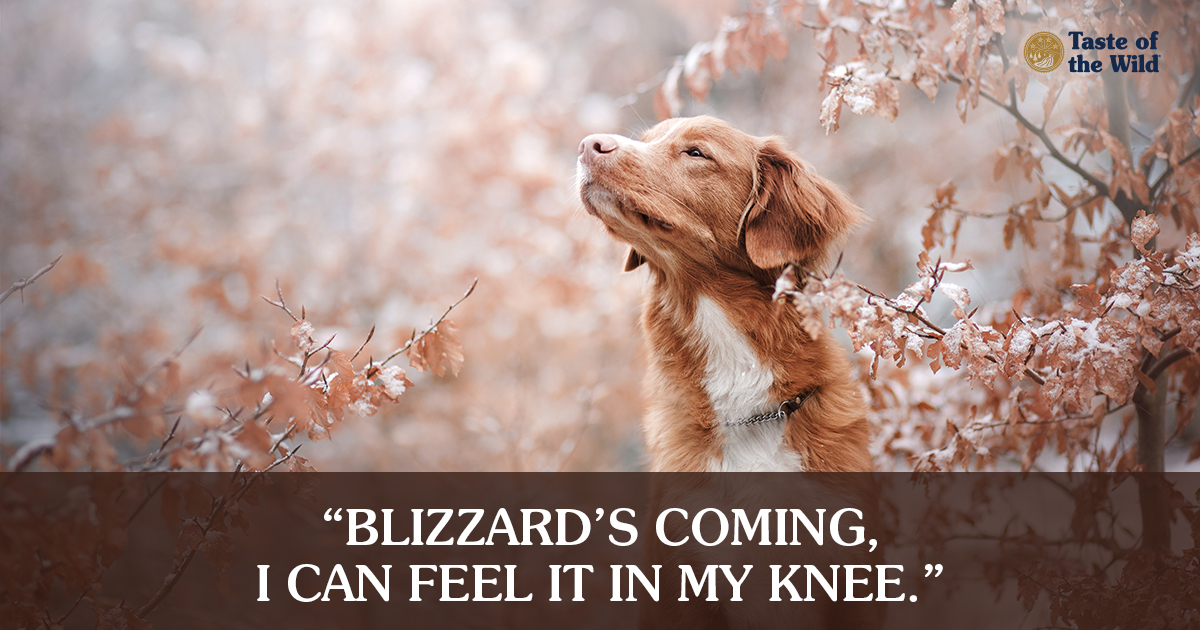Does Cold Weather Affect Your Dog’s Arthritic Joints?
Thursday, January 20, 2022 | Health

Some people with osteoarthritis (OA) claim they can predict the onset of cold weather through their joints. “Blizzard’s coming, I can feel it in my knee,” your grandfather may quip. If cold weather makes human joints feel stiff and achy, there’s a pretty good chance it can have the same effect on your dog.
While human research is inconclusive on why this might happen, there are several theories. In osteoarthritic joints, the cartilage covering the surface of the bones is damaged or worn away, exposing sensitive nerves underneath. It’s possible that changes in barometric pressure may further irritate the nerves, causing additional pain.
The synovial fluid inside the joint is typically a little thicker than water. Cold weather may increase the viscosity of the fluid, making the joint feel stiffer. It’s also possible that lower temperatures can make the muscles supporting the joint less flexible. And certainly, people may stay indoors more in the winter, so a pet with arthritis may not get the regular walks and exercise he or she needs to maintain mobility. So, what’s a dog owner to do?
Keep your arthritic dog comfortable in the winter
Here are some simple things you can do to help your dog:
- Watch the weight — If your dog is carrying a few extra pounds, that weight is putting extra stress on the joints. Keeping your dog lean can help reduce pain.
- Provide regular, low-impact exercise — Walking is important to control weight and “motion is lotion,” meaning it helps keep muscles, ligaments, and joints in good working order.
- Ask your veterinarian about pain relief — Some dogs benefit from medications like non-steroidal anti-inflammatory drugs (NSAIDs), which make it easier for them to keep moving.
- Cozy up the bedding — Add an extra blanket to the dog bed for added warmth and to help cushion achy bones. Avoid electric blankets, or at least make sure there’s a towel between the blanket and your pet, to avoid burning tender skin.
- Add a layer of insulation — Short-haired dogs may benefit from a warm sweater, even when indoors.
- Look into physical therapy — Dogs with advanced arthritis may benefit from therapies such as warm, underwater treadmills. Many therapists can also provide massage and range of motion exercises.
- Use warm and cool compresses — Before exercise, you can apply warm compresses to joints to loosen up tight muscles (again, never place hot compresses directly on the skin). After exercise, icing the affected joint(s) can help reduce swelling and inflammation.
- Cover slippery floors with non-skid rugs — Giving your dog traction can help prevent painful falls, especially if your dog comes in from outdoors with snow on his or her paws.
- Provide carpeted ramps — These can make it easier for dogs to get into and out of cars, or to climb and descend stairs.
If you have any questions about how you can help your arthritic dog get the most out of the winter months, your veterinarian can help.
The information in this blog has been developed with our veterinarian and is designed to help educate pet parents. If you have questions or concerns about your pet’s health or nutrition, please talk with your veterinarian.




